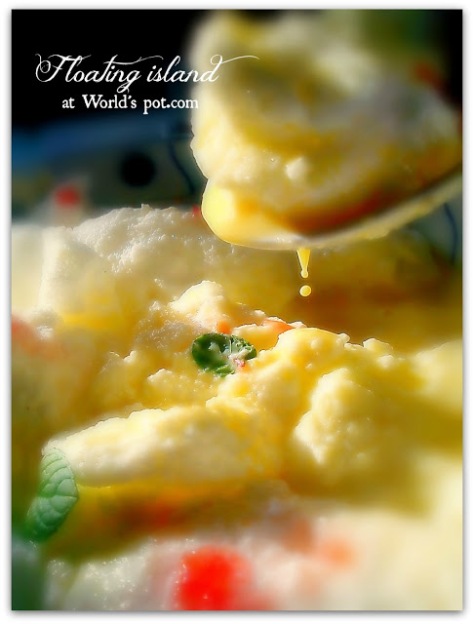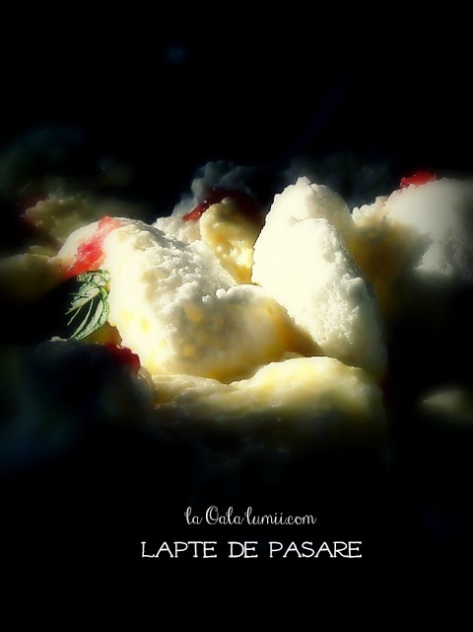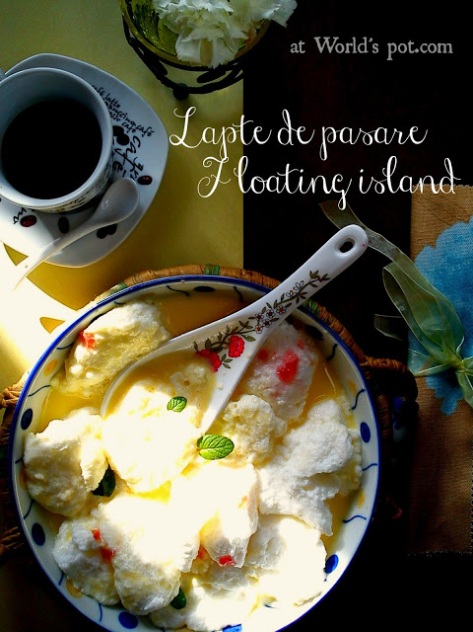(for English version scroll down the page)
Care poate fi legătura dintre insulele naturale plutitoare, laptele de pasăre şi celebra sabie a regelui Arthur ? Poate doar cuvintele, fantezia şi legendele care învelesc într-o aura de mister Avalonul pot să răspundă. Poate doar fantezia carturarilor poate spune dacă Avalon a fost gradina Raiului unde Arthur şi-a alinat rănile bătăliei de la Camlann.
2 albuşe bine bătute cu 1/2 l-ră zahăr şi 1/2 l-ţă extract de vanilie.
Pentru cremă:
Acelaşi lapte, fierbinte, se toarnă cîte puţin peste un amestec făcut din 2 gălbenuşe omogenizate cu 4-5 l-ri de zahăr, 1/2 l-ţă extract de vanilie şi un praf de sare. Se ţine amestecul lichid pe bain-marie pînă capătă o oarecare consistenţă. Se toarnă într-un bol, apoi, la suprafaţa lui se pun ‘gogoaşele’ de albuş.
Se serveşte rece sau la temperatura camerei. Cine doreşte, poate ‘stropi’ totul cu un sirop de trandafiri sau de mure sau de fructe de padure sau….
Natural floating islands may have been the source of many „disappearing island” legends, such as those surrounding Avalon. According to Geoffrey in the Historia and much subsequent literature which he inspired, Avalon is the place where King Arthur is taken after fighting Mordred at the Battle of Camlann to recover from his wounds. The Historia also states that Avalon is where his sword Caliburn (Excalibur) was forged.
„The island of apples which men call “The Fortunate Isle” (Insula Pomorum quae Fortunata uocatur) gets its name from the fact that it produces all things by itself; the fields there have no need of the farmers’ plough. There is no agriculture, except what nature provides. Of its own accord it produces grain and grapes, and apple trees grow in its woods from the close-clipped grass. The ground of its own accord produces everything instead of merely grass, and people live there a hundred years or more. There, nine sisters ruled by a pleasing set of laws, laws brought to them from our country”
By comparison, Isidore’s description of the Fortunate Isles reads:
„The name of the Isles of the Fortunate signifies that they bear all good things, as if they were blessed in the abundance with their fruits. Serviceable by nature (Sua enim aptae natura pretiosarum poma silvarum parturiunt) their hilltops are clothed with vines growing by chance; in place of grasses, there is commonly vegetable and grain. Pagan error and the songs of the secular poets have held that these islands to be Paradise because of the fecundity of the soil. Situated in the Ocean to the West of Mauretania, they are separated by the sea waves. In medieval geographies, Isidore’s Fortunate Islands were identified with the Canaries”
It can be a lost island or can be a sweet stuff, the mystery remains because……
A floating island is a French dessert consisting of meringue floating on crème anglaise (a vanilla custard). The meringues are prepared from whipped egg whites, sugar and vanilla extract then quickly poached. The crème anglaise is prepared with the egg yolks, vanilla and hot milk, briefly cooked.
The whites can be shaped with spoons and allowed to cook gently in boiling sweetened milk with vanilla flavoring. A custard is made using milk, sugar, vanilla and egg yolks; the mix is cooked in a bain-marie for a few minutes, but must remain thin enough to pour. The custard is topped with the egg whites dumplings. The dish is served at room temperature or cold.
Usually the milk mix is thin, almost liquid and the dumplings „float” on top.
For ‘dumplings ‘:
-some about 400-500 ml of boiling milk ( it’s used for custard also)
Custard:
2 egg yolks
4-5 tbs of sugar
a pinch of salt
1/2 tsp of vanilla extract
When milk starts to boil add ‘dumplings’ of whites, taken with a metal spoon. Let’em there for 1 minute. Turn them on both sides and then, remove all of them on a plate.
The same hot milk is poured in small quantities over the mix made from de rest of the ingredients for custard. Boil all in bain-marie for few minutes till the creme gets a thin consistency.
If you like, you can sprinkle all over with a rose syrup or a blackberry syrup or a berries syrup or…whatever syrup you prefer.



un gălbenuș, doua galbenusuri…..
ApreciazăApreciază
O gogoașa, doua gogoși….
ApreciazăApreciază
Un albus, doua albuse, nu? 😀 si mai sunt citeva intentionat lasate asa cum le-ai vazut! Esti draguta, multumesc pt atentionare!
ApreciazăApreciază
Mmm… Dacă ar trebui să vorbesc, mi-ar fi imposibil ! Eu nu l-am făcut niciodată, dar mama mea prepara adesea desertul ăsta magic. Las’ pe mine !
ApreciazăApreciază
Musai sa-l faci pentru ca … merita! Sa-mi dai de stire cum a iesit desi sunt sigura ca va fi mai mult decit perfect. Doar una-i Zina Doamna!
ApreciazăApreciat de 1 persoană
Mulțumesc frumos, nu merit… !
Să știi că am cumpărat ouă de țară și am să fac desertul ăsta pentru masa de duminică. Abia aștept !
ApreciazăApreciază
Am făcut lapte de pasăre, a ieșit minunat. Ai mei abia așteaptă să mai fac. Scuze, am uitat să-ți scriu la momentul oportun, dar nu am uitat să pun în articol un link către rețeta ta !
Să ai o săptămână bună, Lăcrămioara !
ApreciazăApreciat de 1 persoană
Ohhh, ce ma bucur ! Zina Doamna, un stomac multumit inseamna si-un suflet „cumintit”…la un moment dat. Cam asta zicea mosul meu din virf de munte… Te pup cu drag!
ApreciazăApreciază
Foarte bun laptele de pasare, mama il facea si ne mai pregatea un desert, un fel de budinca de gris la cuptor peste care turna lapte cald. Cam ca un pandispan cu gris si cu sirop din lapte. Imi pare rau ca nu am pastrat nicio reteta de la ea. O saptamana buna, Mala! ❤
ApreciazăApreciat de 1 persoană
Tocmai din motivul asta a aparut Oala lumii, de-a nu lasa retetele vechi sa se duca pe apa simbetei… si, da, stiu despre ce reteta vorbesti… o bunaciune extraordinara!
Un blat simplu de tort in care, faina e inlocuita cu gris, copt exact la fel ca blatul. Peste el se toarna lapte fierbinte, dulce si vanilat, totul dupa gust. Cantitatea de lapte e in functie de cit de umed se vrea a fi blatul.
Pup July … ❤
ApreciazăApreciat de 1 persoană
Daa, era mai bun decat orice alt tort.
ApreciazăApreciat de 1 persoană
Cam asa arata … https://www.facebook.com/permalink.php?story_fbid=793793724028648&id=225833727491320
ApreciazăApreciat de 1 persoană